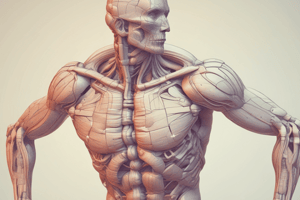Podcast
Questions and Answers
What is the primary reason for assessing passive range of motion?
What is the primary reason for assessing passive range of motion?
- To determine the amount of movement possible at a joint (correct)
- To evaluate joint pain
- To instruct patients on exercises
- To assess muscle strength
Why is passive ROM usually slightly greater than active ROM?
Why is passive ROM usually slightly greater than active ROM?
- Due to the therapist's skill during passive ROM
- Due to the patient's cooperation during assessment
- Due to the slight elastic stretch of tissues or decreased bulk of relaxed muscles (correct)
- Due to the patient's effort during active ROM
What is the purpose of determining the end feel during passive ROM assessment?
What is the purpose of determining the end feel during passive ROM assessment?
- To assess muscle strength
- To indicate the structures that limit joint movement (correct)
- To measure joint pain
- To determine the range of motion
What is necessary to isolate movement during end feel assessment?
What is necessary to isolate movement during end feel assessment?
What does a normal end feel indicate?
What does a normal end feel indicate?
What is an abnormal end feel indicative of?
What is an abnormal end feel indicative of?
What is the purpose of stabilizing the site of attachment of the muscle origin during muscle testing?
What is the purpose of stabilizing the site of attachment of the muscle origin during muscle testing?
What is a factor that affects the strength of a muscle?
What is a factor that affects the strength of a muscle?
Why is it important to assess the strength of the uninvolved limb first during muscle testing?
Why is it important to assess the strength of the uninvolved limb first during muscle testing?
What is a consideration when testing the flexor carpi ulnaris muscle?
What is a consideration when testing the flexor carpi ulnaris muscle?
What is the primary purpose of active range of motion testing?
What is the primary purpose of active range of motion testing?
What is a contraindication for passive range of motion testing?
What is a contraindication for passive range of motion testing?
What is a factor that can increase muscle strength?
What is a factor that can increase muscle strength?
Why is it important to consider the joint position during muscle testing?
Why is it important to consider the joint position during muscle testing?
What is used to measure joint mobility?
What is used to measure joint mobility?
What is a precaution for assessing joint mobility in patients?
What is a precaution for assessing joint mobility in patients?
What is the effect of age on range of motion?
What is the effect of age on range of motion?
What is the difference between active and passive range of motion testing?
What is the difference between active and passive range of motion testing?
What is a factor that influences range of motion?
What is a factor that influences range of motion?
What is a contraindication for range of motion testing?
What is a contraindication for range of motion testing?
Flashcards are hidden until you start studying
Study Notes
Fatigue
- Muscle strength decreases as a patient fatigues
Contraindications and Precautions
- Contraindications: inflammation, presence of pain
- Precautions: patient with cardiovascular problems, abdominal surgery or herniation, malnutrition, malignancy, severe or chronic obstructive pulmonary disease
Factors Influencing Range of Motion
- Age:
- 1-20: ROM increases
- 20-30: ROM decreases
- 30-60: ROM plateau
- 60-die: ROM decreases
- Sex: women have a greater ROM than men
- Joint structures: body type influences joint mobility due to genetics or posture
Types of Motion
- Active range of motion testing: evaluates coordination of movement and functional ability
- Passive range of motion testing: provides information about the integrity of the joint but not about contractile tissue
Contraindications and Precautions for Range of Motion Testing
- Contraindications:
- Dislocation or unhealed fracture
- Immediately following surgical procedures
- In presence of myositis ossificans
- Precautions:
- Infections or inflammatory process in a joint or region
- Patient on medication for pain or muscle relaxants
- Region of marked osteoporosis
- Hyper mobile or subluxed joint
- Painful conditions
- Patient with hemophilia
- Region of hematoma
- Assessing joints with bony ankylosis
- Immediately after an injury of soft tissue
Assessment of Active Range of Motion
- The patient performs active movements and the therapist observes
- Level of consciousness, attention span, and joint ROM movements can cause or increase pain
- Active range of motion may be decreased
Muscle Testing Assessment Procedure
- Explanation and instruction: explains briefly the movement to be performed
- Assessment of normal muscle strength: initially assess and record the strength of the uninvolved limb
- Patient position: positions the patient to isolate the muscle or muscle group to be tested
- Stabilization: stabilizes the site of attachment of the origin of the muscle to prevent substitutions and trick movements
Muscle Grading
- Factors affecting strength:
- ATP
- Muscle size
- Joint position
- Angle of muscle pulls
- Length tension relation
- Previous training effect
- Speed of muscle contraction
Assessment of Passive Range of Motion
- Passive ROM is assessed to determine the amount of movement possible at a joint
- Passive ROM is usually slightly greater than active ROM
- The therapist takes body segments through a passive ROM to estimate each joint's range of motion and determine the quality of movement throughout the ROM
- End feel: the sensation felt by the therapist's hands at the extreme end of passive ROM, indicating the structures that limit joint movement
Studying That Suits You
Use AI to generate personalized quizzes and flashcards to suit your learning preferences.




